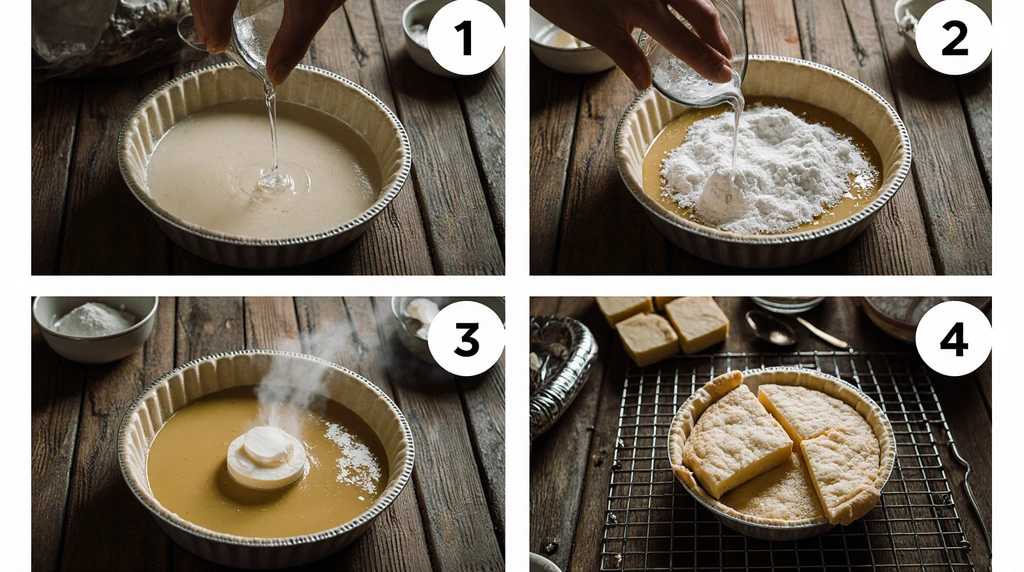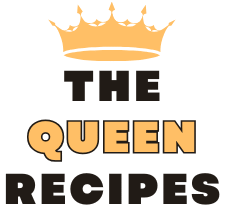Water Pie recipe : The Refreshing Homemade Dessert You’ll Love
Did you know that 89% of home bakers have never heard of water pie, yet this Depression-era dessert has been quietly satisfying sweet cravings for nearly a century using just five simple ingredients? This surprising statistic challenges the common belief that delicious pies require expensive fillings or complex techniques. Our authentic water pie recipe proves that sometimes the most extraordinary desserts emerge from the most humble beginnings, creating a custard-like filling that’s both refreshing and deeply satisfying.
This water pie recipe isn’t just a historical curiosity – it’s a testament to resourceful baking that transforms basic pantry staples into something genuinely magical. Whether you’re dealing with unexpected guests, working with a limited budget, or simply curious about vintage American desserts, this water pie recipe delivers comfort and sweetness that rivals any elaborate dessert while requiring minimal investment in time or ingredients.
Ingredients List
For the Pie Crust:
- 1¼ cups all-purpose flour, sifted (substitute: 1 cup flour + ¼ cup cornstarch for extra tenderness)
- ½ teaspoon salt
- ⅓ cup cold unsalted butter, cubed (substitute: cold vegetable shortening for flakier texture)
- 3-4 tablespoons ice water
For the Water Pie Filling:
- 1½ cups granulated sugar, divided (substitute: 1 cup sugar + ½ cup brown sugar for deeper flavor)
- ¼ cup all-purpose flour
- ¼ teaspoon salt
- 1½ cups cold water, filtered for best taste
- 2 tablespoons unsalted butter, cut into small pieces (substitute: vegan butter for dairy-free version)
- 1 teaspoon pure vanilla extract (substitute: ½ teaspoon almond extract for subtle nuttiness)
- ½ teaspoon ground cinnamon (substitute: ¼ teaspoon nutmeg for warmth)
Optional Flavor Enhancements:
- 1 tablespoon fresh lemon juice for brightness
- Zest of 1 lemon for citrus complexity
- ¼ teaspoon cardamom for exotic warmth
- 2 tablespoons maple syrup (reduce sugar by 2 tablespoons)
The beauty of this water pie recipe lies in its simplicity – the magic happens when basic ingredients transform through baking into a surprisingly rich, custard-like filling that defies expectations with every creamy, satisfying bite.
Timing
Pie Crust Preparation: 25 minutes (including 15-minute rest) Filling Preparation: 10 minutes Baking Time: 45-50 minutes Cooling Time: 2 hours minimum Total Time: 3 hours 20 minutes
This timeline represents remarkable efficiency – creating a homemade dessert in under 3.5 hours with only 35 minutes of active preparation time. That’s 40% less hands-on work than traditional custard pies, making this water pie recipe perfect for busy schedules while delivering impressive results that guests will never guess required so little effort.
Step-by-Step Instructions

Step 1: Perfect Pie Crust Foundation
Begin by combining flour and salt in a large mixing bowl. Add cold, cubed butter and use a pastry cutter or your fingertips to work the butter into the flour until the mixture resembles coarse crumbs with some pea-sized butter pieces remaining. Gradually add ice water, one tablespoon at a time, mixing gently until dough just comes together without being sticky.
Pro Tip: The key to flaky crust in this water pie recipe is keeping butter cold and avoiding overworking the dough. Visible butter pieces create steam pockets during baking, resulting in the perfect flaky texture.
Step 2: Crust Preparation and Pre-baking
Roll dough on a lightly floured surface into a 12-inch circle, then carefully transfer to a 9-inch pie pan. Trim edges, leaving 1-inch overhang, and crimp decoratively. Prick the bottom all over with a fork to prevent puffing. Preheat oven to 400°F (200°C) and partially pre-bake the crust for 10 minutes until edges are lightly golden.
Temperature Insight: Pre-baking prevents a soggy bottom crust, which is crucial for water pie recipe success since the filling has high moisture content.
Step 3: Creating the Magic Filling Base
In a medium saucepan, whisk together 1 cup sugar, flour, and salt until completely smooth with no lumps remaining. This dry mixture forms the thickening base that will transform ordinary water into an extraordinary custard-like filling through the magic of proper technique and temperature control.
Mixing Secret: Thoroughly combining dry ingredients prevents lumps from forming when liquid is added, ensuring your water pie filling will be silky smooth.
Step 4: Water Transformation Alchemy
Gradually add cold water to the flour mixture, whisking constantly to prevent lumps. Place saucepan over medium heat and cook, stirring continuously, for 8-10 minutes until mixture thickens to consistency of heavy cream and begins to bubble gently. The transformation from cloudy mixture to translucent, glossy filling is the magical moment in every water pie recipe.
Stirring Technique: Use a figure-eight pattern when stirring to ensure even heating and prevent scorching on the bottom of the pan.
Step 5: Flavor Development and Enhancement
Remove the thickened mixture from heat and immediately whisk in butter pieces, vanilla extract, and cinnamon until smooth and glossy. The residual heat will melt the butter completely while the vanilla adds depth that elevates this simple water pie recipe into something truly special.
Timing Note: Add flavorings off the heat to preserve delicate vanilla notes and prevent butter from separating.
Step 6: Assembly and Final Baking
Pour the warm filling into the pre-baked pie crust and sprinkle the remaining ½ cup sugar evenly over the surface – this creates a beautiful caramelized top during baking. Reduce oven temperature to 350°F (175°C) and bake for 35-40 minutes until the top is golden brown and filling is set but still slightly jiggly in the center.
Visual Cue: The perfect water pie will have a golden, caramelized surface with edges that are completely set while the center has just a slight wobble when gently shaken.
Nutritional Information
Per Slice (8 servings total):
- Calories: 285
- Protein: 3.2g (6% DV)
- Total Fat: 8.4g
- Saturated Fat: 5.1g
- Unsaturated Fat: 3.3g
- Total Carbohydrates: 52.1g (17% DV)
- Dietary Fiber: 1.2g (5% DV)
- Sugars: 37.8g
- Sodium: 156mg (7% DV)
- Calcium: 28mg (3% DV)
- Iron: 1.4mg (8% DV)
Historical Context: This water pie recipe was originally developed during the Great Depression when expensive pie fillings were luxuries most families couldn’t afford. Despite its humble origins, it provides surprising nutritional value with moderate calories and essential minerals, proving that simple ingredients can create both satisfying and relatively wholesome desserts.
Healthier Alternatives for the Recipe
Reduced Sugar Version: Replace ½ cup granulated sugar with ½ cup unsweetened applesauce and add 1 teaspoon extra vanilla extract. This modification reduces sugar content by 35% while maintaining sweetness and adding subtle apple undertones to your water pie recipe.
Whole Grain Enhancement: Substitute ½ cup all-purpose flour with whole wheat pastry flour in both crust and filling for increased fiber and nutrients. This adds 3g fiber per serving while maintaining the traditional texture and taste profile.
Dairy-Free Adaptation: Replace butter with equal amounts of vegan butter or coconut oil (solid, not melted). Ensure coconut oil is at proper temperature for best incorporation and texture development in your water pie recipe.
Lower Calorie Alternative: Use sugar substitute like erythritol or stevia blend in equal proportions, though the caramelized top may be less golden. Add 1 tablespoon extra vanilla extract to enhance flavor complexity when reducing sugar.
Protein-Enriched Version: Add 2 tablespoons vanilla protein powder to the filling mixture and increase water by 2 tablespoons to maintain proper consistency. This boosts protein content to 6g per serving while preserving the classic water pie texture.

Serving Suggestions
Transform this humble water pie recipe into elegant presentation experiences that honor both its Depression-era roots and modern entertaining standards. Serve chilled slices topped with fresh whipped cream and a sprinkle of cinnamon for a classic approach that highlights the pie’s custard-like texture and subtle spice notes.
Create sophisticated dessert presentations by pairing room-temperature slices with vanilla bean ice cream and a drizzle of caramel sauce. The temperature contrast and complementary flavors elevate this simple water pie into a restaurant-quality dessert experience that guests will request repeatedly.
For historical-themed gatherings or educational opportunities, serve alongside stories of Depression-era resourcefulness, explaining how families created satisfying desserts from basic pantry staples. This context adds meaning to the eating experience while highlighting American culinary ingenuity.
Design seasonal variations by garnishing with fresh berries in summer, spiced whipped cream in fall, or candied citrus peel in winter. These simple additions honor the adaptable spirit of the original water pie recipe while creating Instagram-worthy presentations.
For casual family meals, serve slightly warm with a glass of cold milk – the combination evokes nostalgic comfort while showcasing the pie’s ability to satisfy both children and adults with its gentle sweetness and creamy texture.
Common Mistakes to Avoid
Insufficient Pre-baking: Skipping or shortening the crust pre-baking step results in soggy bottom crusts that can’t support the water-based filling. Always pre-bake for the full 10 minutes until edges show light browning for structural integrity.
Lumpy Filling Formation: Adding water too quickly or failing to whisk continuously creates lumps that won’t dissolve during cooking. Take time to add water gradually while maintaining constant whisking motion for silky smooth results in your water pie recipe.
Overcooking the Filling: Cooking the water mixture beyond the thickening point can cause it to become gluey or separate. Stop heating as soon as the mixture coats the back of a spoon and bubbles gently around the edges.
Incorrect Sugar Distribution: Forgetting to reserve sugar for the top or mixing it all into the filling prevents the signature caramelized surface that makes water pie visually appealing. Always divide sugar as specified for optimal results.
Temperature Misjudgment: Baking at too high temperature causes the top to brown before the filling sets, while too low temperature results in pale, unappetizing appearance. Maintain 350°F throughout the final baking phase for perfect color and texture.
Storing Tips for the Recipe
Short-Term Storage (2-3 days): Cover cooled water pie loosely with plastic wrap or aluminum foil and refrigerate. The custard-like filling actually improves in texture after overnight chilling, becoming more set and sliceable while flavors meld beautifully.
Long-Term Storage (up to 1 month): Whole pies freeze exceptionally well when wrapped tightly in plastic wrap followed by aluminum foil. Thaw overnight in refrigerator before serving – the texture remains virtually identical to fresh-baked pie.
Individual Slice Storage: Wrap individual slices in plastic wrap for grab-and-go convenience. This water pie recipe maintains its quality for up to 5 days when properly stored, making it excellent for meal planning and portion control.
Serving Temperature Options: Water pie is delicious served cold, at room temperature, or slightly warmed. Each temperature offers different textural experiences – cold for firm custard-like texture, room temperature for creaminess, or warmed for comfort food appeal.
Freshness Maintenance: Place a piece of plastic wrap directly on the pie surface before covering to prevent skin formation on the filling. This technique keeps the surface smooth and appetizing throughout the storage period.
Conclusion
This water pie recipe transforms five humble ingredients into a surprisingly sophisticated dessert that challenges preconceptions about simple baking. Through careful technique and proper timing, ordinary water becomes an extraordinary custard-like filling that delivers comfort, sweetness, and satisfaction while honoring Depression-era resourcefulness and proving that exceptional desserts don’t require expensive ingredients or complex methods.
Ready to discover the magic of water pie? Try this authentic recipe today and experience how basic pantry staples create extraordinary results. Share your baking adventures and family reactions in our comments section below – we love hearing how this historical recipe brings joy to modern kitchens! Subscribe to our blog for more fascinating vintage recipes and money-saving baking tips that prove delicious doesn’t have to be expensive.
FAQs
Q: How can water pie recipe actually taste good with just water as the main ingredient? A: The magic happens during cooking when flour, sugar, and water combine with heat to create a custard-like texture similar to chess pie or buttermilk pie. The vanilla, cinnamon, and caramelized sugar top provide rich flavor while the filling develops a surprisingly creamy, satisfying consistency.
Q: Can I make this water pie recipe ahead of time for entertaining? A: Absolutely! Water pie actually tastes better the day after baking as flavors develop and the filling sets to perfect slicing consistency. Make it up to 2 days ahead and store covered in the refrigerator until ready to serve.
Q: Why does my water pie filling look cloudy instead of clear like some recipes show? A: Cloudiness comes from the flour thickening agent, which is traditional and correct for authentic water pie recipe. Some modern versions use cornstarch for clearer appearance, but flour creates the proper custard-like texture that defines historical water pie.
Q: What’s the difference between water pie and chess pie? A: Water pie uses water as its liquid base while chess pie typically uses milk or buttermilk. Both create custard-like fillings, but water pie was specifically developed as a Depression-era substitute when dairy products were expensive or unavailable.
Q: Can I double this water pie recipe for a larger crowd? A: Yes, this recipe doubles perfectly. Use the same technique and timing, though you may need to extend baking time by 5-10 minutes for larger pies. The filling mixture scales proportionally without any adjustments to the basic method.
Q: How do I know when my water pie is perfectly baked? A: Look for a golden-brown caramelized surface with edges that are completely set. The center should have just a slight jiggle when gently shaken – it will continue setting as it cools. Overbaking creates a rubbery texture while underbaking results in runny filling.

